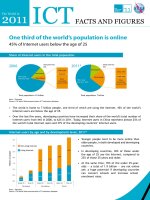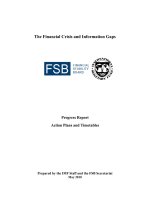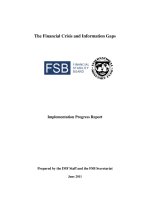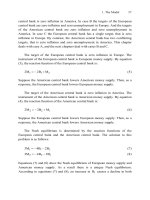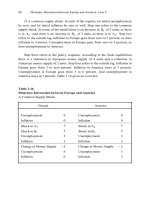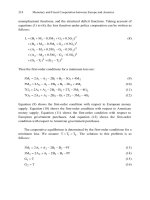varoufakis - the global minotaur; america, the true origins of the financial crisis and the future of the world economy (2011)
Bạn đang xem bản rút gọn của tài liệu. Xem và tải ngay bản đầy đủ của tài liệu tại đây (2.42 MB, 266 trang )
Zed Books is an independent progressive publisher with a
reputation for cutting-edge international publishing. Innovative
and thought-provoking, the Economic Controversies series
strips back the often impenetrable façade of economic jargon
to present bold new ways of looking at pressing issues, while
explaining the hidden mechanics behind them. Concise and
accessible, the books bring a fresh, unorthodox approach to a
variety of controversial subjects.
Series editor Edward Fullbrook is the founder and editor of
the Real World Economics Review (formerly the Post-Autistic
Economics Review), which has over , subscribers. As well
as editing a number of books on economics, including Pluralist
Economics () and A Guide to What’s Wrong with Economics
(), his essays on economics and philosophy have appeared
in numerous anthologies and journals.
About the author
Yanis Varoufakis is Professor of Economic Theory at the
University of Athens, Greece, where he now lives after more
than two decades of studying and teaching in Britain and
Australia (where he held academic posts, in reverse order, at the
Universities of Sydney, Glasgow, Cambridge and East Anglia).
This is his rst book aimed at the general reader. His more
stuy books include Rational Conict (), Foundations of
Economics () and (with Shaun Hargreaves Heap) Game
Theory: A critical text ().
The Global Minotaur
America, the True Origins
of the Financial Crisis and the
Future of the World Economy
Yanis Varoufakis
Zed Books
London & New York
Z
The Global Minotaur: America, the True Origins of the Financial Crisis and
the Future of the World Economy was rst published in 2011 by
Zed Books Ltd, 7 Cynthia Street, London N1 9JF, UK and Room 400, 175
Fifth Avenue, New York, NY 10010, USA
www.zedbooks.co.uk
Copyright © Yanis Varoufakis 2011
The right of Yanis Varoufakis to be identied as the author of this work
has been asserted by him in accordance with the Copyright, Designs
and Patents Act, 1988.
Typeset in Bulmer MT
by Bookcraft Ltd, Stroud, Gloucestershire
Index by Sally Phillips
Cover designed by www.alice-marwick.com
Distributed in the USA exclusively by Palgrave Macmillan, a division of
St Martin’s Press, LLC, 175 Fifth Avenue, New York, NY 10010, USA
All rights reserved. No part of this publication may be reproduced,
stored in a retrieval system or transmitted in any form or by any means,
electronic, mechanical, photocopying or otherwise, without the prior
permission of Zed Books Ltd.
A catalogue record for this book is available from the British Library.
Library of Congress Cataloging in Publication Data available
ISBN 978 1 78032 016 8 eb
Contents
, vi
viii
x
Introduction
Laboratories of the future
The Global Plan
The Global Minotaur
The beast’s handmaidens
Crash
The handmaidens strike back
The Minotaur’s global legacy: the dimming
sun, the wounded tigers, a ighty Europa and
an anxious dragon
A future without the Minotaur?
Figures, tables and boxes
Figures
. US national income
. Real GDP per capita during the period of the
Global Plan
. Stagnating wages, booming productivity
. Index of average real US prot rates
. The Global Minotaur in two diagrams
. Eects of the Global Minotaur on the relative
position of the United States
. Correlation between median house price ination
and the growth in consumer spending, –
. Increase in US assets owned by foreign state
institutions
Tables
. Percentage change in a country’s share of world GDP
. Average annual rate of change in labour unit costs
Boxes
. The Cretan Minotaur
. Pre- crises
. When reason defers to expectation
. Surplus recycling mechanisms: capitalism’s sine
qua non
. The Global Plan’s architects
. Who were the handmaidens?
. Wishful thinking – how mergers and acquisitions
created ctitious value
. Walmart: a corporation after the Minotaur’s heart
. The trickle-up eect
. Credit default swaps (CDS)
. Failure pays
. Europa’s ight
. America’s bankers
Abbreviations
AC alternating current
ACE aeronautic–computer–electronics complex
AIG American Insurance Group
ATM automated telling machine
CDO collateralized debt obligation
CDS credit default swap
CEO chief executive ocer
DC direct current
ECB European Central Bank
ECSC European Coal and Steel Community
EFSF European Financial Stability Facility
EIB European Investment Bank
EMH Ecient Market Hypothesis
ERAB Economic Recovery Advisory Board
EU European Union
FDIC Federal Deposit Insurance Corporation
GDP gross domestic product
GM General Motors
GSRM global surplus recycling mechanism
ix
IBRD International Bank for Reconstruction and
Development
ICU International Currency Union
IMF International Monetary Fund
LTCM Long-Term Capital Management (name of a hedge
fund)
MIE military-industrial establishment
NAFTA North American Free Trade Agreement
NATO North Atlantic Treaty Organization
OECD Organisation for Economic Co-operation and
Development
OEEC Organisation for European Economic Co-operation
OPEC Organization of the Petroleum Exporting Countries
RBCT Real Business Cycle Theory
RBS Royal Bank of Scotland
REH Rational Expectations Hypothesis
RMB renminbi – Chinese currency
SME small and medium-sized enterprise
SPV Special Purpose Vehicle
TARP Troubled Asset Relief Program
Acknowledgements
The Global Minotaur is a metaphor that crept up on me during
endless conversations with Joseph Halevi on what made the
world tick after the economic crises of the s. Our conversa-
tions were long, repetitive and animated. They took place over
two decades in Australia, in Europe, face to face, by email, in
an assortment of media and moods. Nevertheless, gradually
they led us to a coherent view of the global economic system in
which America’s decits played a dening and, paradoxically,
hegemonic role.
That viewpoint rst saw the light of day in , in an article
published by Monthly Review, under the same title: ‘The
Global Minotaur’. In it, Joseph and I put forward the working
hypothesis that the dening characteristic of the global polit-
ical economy was the reversal of the ow of trade and capital
surpluses between the United States and the rest of the world.
The hegemon, for the rst time in world history, strengthened
its hegemony by wilfully enlarging its decits, once it had lost
its surplus global position. The trick was to understand how
America did this and the tragic manner in which its success gave
rise to the nancialization that both reinforced US dominance
xi
and, simultaneously, implanted the seeds of its potential
downfall.
It was an attractive story that seemed to resonate power-
fully with many dierent people’s thinking about our brave
globalizing world. And when the Crash of struck, our story
began to make even more sense – at least to us. In response to
the ensuing crisis, Joseph and I enlisted Nicholas Theocarakis,
our good friend and colleague, to tell a larger story: a tale of how
the events of marked a break with the past both for global
capitalism and for the way in which, as economists, we can make
sense of it.
The result was a recent academic book, entitled Modern
Political Economics, in which the Global Minotaur made its
presence felt on almost every page. As it was a book aimed at our
academic colleagues and students, its basic narrative was inter-
twined with elaborate discussions and inane mental excursions
that would drive sensible non-academic readers crazy. Thus,
the idea occurred to me of distilling the crux of the Global
Minotaur story in the book you are now holding.
Besides thanking Joseph and Nicholas for the shared
thoughts that have trickled into the following pages, I must
also thank: George Krimpas for spiritual encouragement,
intellectual guidance and much-needed corrections, Nicholas
Theocarakis (again) for meticulous proof-reading of an earlier
draft, Alejandro Nadal for some excellent comments and Clive
Liddiard for inspired copy-editing. Lastly, I owe a debt of
gratitude to Rob Langham, of Routledge, who suggested that
I approach Zed Books with the idea for this project, and, natu-
rally, Ken Barlow of Zed Books for embracing my idea warmly
and eciently.
For Danaë Stratou,
my global partner
Introduction
The 2008 moment
Nothing humanizes us like aporia – that state of intense puzzle-
ment in which we nd ourselves when our certainties fall to
pieces; when suddenly we get caught in an impasse, at a loss to
explain what our eyes can see, our ngers can touch, our ears can
hear. At those rare moments, as our reason valiantly struggles to
fathom what the senses are reporting, our aporia humbles us
and readies the prepared mind for previously unbearable truths.
And when the aporia casts its net far and wide to ensnare the
whole of humanity, we know we are at a very special moment in
history. September was just such a moment.
The world had just astonished itself in a manner not seen
since . The certainties that decades of conditioning had
led us to acknowledge were, all of a sudden, gone, along with
around $ trillion of equity globally, $ trillion of household
wealth in the US alone, , US jobs every month, count-
less repossessed homes everywhere The list is almost as long
as the numbers on it are unfathomable.
The collective aporia was intensied by the response of
governments that had hitherto clung tenaciously to scal
conservatism as perhaps the twentieth century’s last surviving
mass ideology: they began to pour trillions of dollars, euros,
yen, etc. into a nancial system that had, until a few months
before, been on a huge roll, accumulating fabulous prots
and provocatively professing to have found the pot of gold at
the end of some globalized rainbow. And when that response
proved too feeble, our presidents and prime ministers, men
and women with impeccable anti-statist, neoliberal creden-
tials, embarked upon a spree of nationalizing banks, insurance
companies and car manufacturers that put even Lenin’s post-
exploits to shame.
Unlike previous crises, such as the dotcom crash of ,
the recession, Black Monday,
the s Latin American
debacle, the slide of the Third World into a vicious debt trap, or
even the devastating early s depression in Britain and parts
of the US, this crisis was not limited to a specic geography, a
certain social class or particular sectors. All the pre- crises
were, in a sense, localized. Their long-term victims were hardly
ever of importance to the powers-that-be, and when (as in the
case of Black Monday, the Long-Term Capital Management
(LTCM) hedge fund asco of or the dotcom bubble of two
years later) it was the powerful who felt the shock, the authori-
ties had managed to come to the rescue quickly and eciently.
In contrast, the Crash of had devastating eects both
globally and across the neoliberal heartland. Moreover, its
eects will be with us for a long, long time. In Britain, it was
probably the rst crisis in living memory really to have hit the
richer regions of the south. In the United States, although the
sub-prime crisis began in less-than-prosperous corners of that
great land, it spread to every nook and cranny of the privileged
middle classes, its gated communities, its leafy suburbs, the
Ivy League universities where the well-o congregate, queuing
up for the better socio-economic roles. In Europe, the whole
continent reverberates with a crisis that refuses to go away and
which threatens European illusions that had managed to remain
unscathed for six decades. Migration ows were reversed,
as Polish and Irish workers abandoned Dublin and London
alike for Warsaw and Melbourne. Even China, which famously
escaped the recession with a healthy growth rate at a time of
global shrinkage, is in a bind over its falling consumption share of
total income and its heavy reliance on state investment projects
that are feeding into a worrying bubble – two portents that do
not bode well at a time when the rest of the world’s long-term
capacity to absorb the country’s trade surpluses is questionable.
Adding to the general aporia, the high and mighty let it be
known that they, too, were at a loss to grasp reality’s new twists.
In October , Alan Greenspan, the former chairman of the
Federal Reserve (the Fed) and a man viewed as a latter-day
Merlin, confessed to ‘a aw in the model that I perceived is the
critical functioning structure that denes how the world works’.
Two months later, Larry Summers, formerly President Clinton’s
treasury secretary and at the time President-Elect Obama’s chief
economic adviser (head of the National Economic Council),
said that ‘[i]n this crisis, doing too little poses a greater threat
than doing too much ’ When the Grand Wizard confesses to
having based all his magic on a awed model of the world’s
ways, and the doyen of presidential economic advisers proposes
that caution be thrown to the wind, the public ‘gets’ it: our ship
is sailing in treacherous, uncharted waters, its crew clueless, its
skipper terried.
Thus we entered a state of tangible, shared aporia. Anxious
disbelief replaced intellectual indolence. The gures in authority
seemed bereft of authority. Policy was, evidently, being made on the
hoof. Almost immediately, a puzzled public trained its antennae in
every possible direction, desperately seeking explanations for the
causes and nature of what had just hit it. As if to prove that supply
needs no prompting when demand is plentiful, the presses started
rolling. One after another, the books, the articles, the long essays –
even the movies – churned through the pipeline, creating a ood
of possible explanations for what had gone wrong. But while a
world in shock is always pregnant with theories about its predica-
ment, the overproduction of explanations does not guarantee the
aporia’s dissolution.
Six explanations for why it happened
1. ‘Principally a failure of the collective imagination
of many bright people to understand the risks to the
system as a whole’
That was the gist of a letter sent to the Queen by the British
Academy on July , in response to a question she had
put to a gathering of red-faced professors at the London School
of Economics: ‘Why had you not seen it coming?’ In their
letter, thirty-ve of Britain’s top economists answered in eect:
‘Whoops! We mistook a Great Big Bubble for a Brave New
World.’ The gist of their response was that, while they had their
nger on the pulse and their eye on the data, they had made two
related diagnostic mistakes: the error of extrapolation and the
(rather more sinister) error of falling prey to their own rhetoric.
Everyone could see that the numbers were running riot. In the
United States, the nancial sector’s debt had shot up from an
already sizeable per cent of national income (Gross Domestic
Product or GDP) in to per cent in the summer of .
In the meantime, American households saw their debt share of
national income rise from per cent in to per cent ten
years later. Put together, aggregate US debt in exceeded
per cent of GDP, when in it had stood at an already
inated per cent. As for Britain, the City of London (the
nancial sector in which British society had put most of its
eggs, following the rapid deindustrialization of the early s)
sported a collective debt almost two and a half times Britain’s
GDP, while, in addition, British families owed a sum greater
than one annual GDP.
So, if an accumulation of inordinate debt infused more risk
than the world could bear, how come no one saw the crash
coming? That was, after all, the Queen’s reasonable ques-
tion. The British Academy’s answer grudgingly confessed to
the combined sins of smug rhetoric and linear extrapolation.
Together, these sins fed into the self-congratulatory convic-
tion that a paradigm shift had occurred, enabling the world of
nance to create unlimited, benign, riskless debt.
The rst sin, which took the form of a mathematized rhetoric,
lulled authorities and academics into a false belief that nan-
cial innovation had engineered risk out of the system; that the
new instruments allowed a new form of debt with the proper-
ties of quicksilver. Once loans were originated, they were then
sliced up into tiny pieces, blended together in packages that
contained dierent degrees of risk,
and sold all over the globe.
By thus spreading nancial risk, so the rhetoric went, no single
agent faced any signicant danger that they would be hurt if
some debtors went bust. It was a New Age faith in the nancial
sector’s powers to create ‘riskless risk’, which culminated in the
belief that the planet could now sustain debts (and bets made
on the back of these debts) that were many multiples of actual,
global income.
Vulgar empiricism shored up such mystical beliefs: back in
, when the so-called ‘new economy’ collapsed, destroying
much of the paper wealth made from the dotcom bubble and
the Enron-like scams, the system held together. The new
economy bubble was, in fact, worse than the sub-prime mortgage
equivalent that burst six years later. And yet the ill eects were
contained eciently by the authorities (even though employ-
ment did not recover until –). If such a large shock could
be absorbed so readily, surely the system could sustain smaller
shocks, like the $ billion sub-prime losses of –.
According to the British Academy’s explanation (which, it
must be said, is widely shared), the Crash of happened
because by then – and unbeknownst to the armies of hyper-
smart men and women whose job was to have known better – the
risks that had been assumed to be riskless had become anything
but. Banks like the Royal Bank of Scotland, which employed
, ‘risk managers’, ended up consumed by a black hole
of ‘risk gone sour’. The world, in this reading, paid the price
for believing its own rhetoric and for assuming that the future
would be no dierent from the very recent past. Thinking that
it had successfully diused risk, our nancialized world created
so much that it was consumed by it.
2. Regulatory capture
Markets determine the price of lemons. And they do so with
minimal institutional input, since buyers know a good lemon
when they are sold one. The same cannot be said of bonds or,
even worse, of synthetic nancial instruments. Buyers cannot
taste the ‘produce’, squeeze it to test for ripeness, or smell its
aroma. They rely on external, institutional information and
on well-dened rules that are designed and policed by dispas-
sionate, incorruptible authorities. This was the role, suppos-
edly, of the credit rating agencies and of the state’s regulatory
bodies. Undoubtedly, both types of institution were found not
just wanting but culpable.
When, for instance, a collateralized debt obligation (CDO) – a
paper asset combining a multitude of slices of many dierent
types of debt
– carried a triple-A rating and oered a return
per cent above that of US Treasury Bills,
the signicance was
twofold: the buyer could feel condent that the purchase was
not a dud and, if the buyer was a bank, it could treat that piece
of paper as indistinguishable from (and not an iota riskier than)
the real money with which it had been bought. This pretence
helped banks to attain breathtaking prots for two reasons.
If they held on to their newly acquired CDO – and
remember, the authorities accepted that a triple-A rated
CDO was as good as dollar bills of the same face value – the
banks did not even have to include it in their capitalization
computations.
This meant that they could use with impu-
nity their own clients’ deposits to buy the triple-A rated
CDOs without compromising their ability to make new
loans to other clients and other banks. So long as they could
charge higher interest rates than they paid, buying triple-
A rated CDOs enhanced the banks’ protability without
limiting their loan-making capacity. The CDOs were, in
eect, instruments for bending the very rules designed to
save the banking system from itself.
An alternative to keeping the CDOs in the bank vaults was
to pawn them o to a central bank (e.g. the Fed) as collateral
for loans, which the banks could then use as they wished:
to lend to clients, to other banks, or to buy even more
CDOs for themselves. The crucial detail here is that the
loans secured from the central bank by pawning the triple-
A rated CDO bore the pitiful interest rates charged by the
central bank. Then, when the CDO matured, at an interest
rate of per cent above what the central bank was charging,
the banks kept the dierence.
The combination of these two factors meant that the issuers
of CDOs had good cause:
(a) to issue as many of them as they physically could;
(b) to borrow as much money as possible to buy other issuers’
CDOs; and
(c) to keep vast quantities of such paper assets on their books.
Alas, this was an open invitation to print one’s own money! No
wonder Warren Buet took one look at the fabled CDOs and
described them as WMDs (weapons of mass destruction).The
incentives were incendiary: the more the nancial institutions
borrowed in order to buy the triple-A rated CDOs, the more
money they made. The dream of an ATM in one’s living room
had come true, at least for the private nancial institutions and
the people running them.
With these facts before us, it is not hard to come to the conclu-
sion that the Crash of was the inevitable result of granting
to poachers the role of gamekeeper. Their power was blatant
and their image as the postmodern wizards conjuring up new
wealth and new paradigms was unchallenged. The bankers paid
the credit rating agencies to extend triple-A status to the CDOs
that they issued; the regulating authorities (including the central
bank) accepted these ratings as kosher; and the up-and-coming
young men and women who had secured a badly paid job with
one of the regulating authorities soon began to plan a career
move to Lehman Brothers or Moody’s. Overseeing all of them
was a host of treasury secretaries and nance ministers who had
either already served for years at Goldman Sachs, Bear Stearns,
etc. or were hoping to join that magic circle after leaving politics.
In an environment that reverberated with the popping of
champagne corks and the revving of gleaming Porsches and
Ferraris; in a landscape where torrents of bank bonuses ooded
into already wealthy areas (further boosting the real estate boom
and creating new bubbles from Long Island and London’s
East End to the suburbs of Sydney and the high-rise blocks of
Shanghai); in that ecology of seemingly self-propagating paper
wealth, it would take a heroic – a reckless – disposition to sound
the alarm bells, to ask the awkward questions, to cast doubt on
the pretence that triple-A rated CDOs carried zero risk. Even if
some incurably romantic regulator, trader or senior banker were
to raise the alarm, she would be well and truly trumped, ending
up a tragic, crushed gure in history’s gutter.
The Brothers Grimm had a story involving a magic pot
that embodied industrialization’s early dreams – of automated
cornucopias fullling all our desires, unstoppably. It was also a
bleak and cautionary tale that demonstrated how those indus-
trial dreams might turn into a nightmare. For, towards the end
of the story, the wondrous pot runs amok and ends up ooding
the village with porridge. Technology turned nasty, in much
the same way as Mary Shelley’s ingenious Dr Frankenstein had
his own creation turn viciously against him. In similar fashion,
the virtual automated telling machines (ATMs) conjured up by
Wall Street, the credit rating agencies and the regulators who
connived with them ooded the nancial system with a modern-
day porridge, which ended up choking the whole planet. And
when, in autumn of , the ATMs stopped working, a world
addicted to synthesized porridge juddered to a grinding halt.
3. Irrepressible greed
‘It’s the nature of the beast’, goes the third explanation. Humans
are greedy creatures who only feign civility. Given the slightest
chance, they will steal, plunder and bully. This dim view of our
human lot leaves no room even for a modicum of hope that intel-
ligent bullies will consent to rules banning bullying. For even
if they do, who will enforce them? To keep the bullies in awe,
some Leviathan with extraordinary power will be necessary. But
then again, who will keep tabs on the Leviathan?
Such are the workings of the neoliberal mind, yielding the
conclusion that crises may be necessary evils; that no human
design can avert economic meltdowns. For a few decades, begin-
ning with President Roosevelt’s post- attempts to regulate
the banks, the Leviathan solution became widely accepted: the
state could and should play its Hobbesian role in regulating
greed and bringing it into some balance with propriety. The
Glass–Steagall Act of is possibly the most often quoted
example of that regulatory eort.
However, the s saw a steady retreat away from this regula-
tory framework and toward the re-establishment of the fatalistic
view that human nature will always nd ways of defeating its
own best intentions. This ‘retreat to fatalism’ coincided with
the period when neoliberalism and nancialization were rearing
their unsightly heads. This meant a new take on the old fatalism:
the Leviathan’s overwhelming power, while necessary to keep
the bullies in their place, was choking growth, constraining
innovation, putting the brakes on imaginative nance, and thus
keeping the world stuck in a low gear just when technological
innovations oered the potential to whisk us onto higher planes
of development and prosperity.
In , President Reagan decided to replace Paul Volcker
(a Carter administration appointment) as chairman of the
Fed. His choice was Alan Greenspan. Some months later, the
money markets experienced their worst single day ever, the
infamous ‘Black Monday’ episode. Greenspan’s deft handling
of the consequences earned him a reputation for cleaning up
eciently after a money market collapse.
He was to perform
the same ‘miracle’ again and again until his retirement in .
Greenspan had been chosen by Reagan’s staunch neolib-
erals not in spite of but because of his deeply held belief that the
merits and capacities of regulation were overrated. Greenspan
truly doubted that any state institution, including the Fed, could
rein in human nature and eectively restrain greed without, at
the same time, killing o creativity, innovation and, ultimately,
growth. His belief led him to adopt a simple recipe, which
shaped the world for a good nineteen years: since nothing disci-
plines human greed like the unyielding masters of supply and
demand, let the markets function as they will, but with the state
remaining ready and willing to step in to clean up the mess when
the inevitable disaster strikes. Like a liberal parent who lets his
children get into all sorts of mischief, he expected trouble but
thought it better to remain on the sidelines, always ready to step
in, clean up after a boisterous party, or tend to the wounds and
the broken limbs.
Greenspan stuck to his recipe, and this underlying model
of the world, in each and every downturn that occurred on
his watch. During the upturns, he would sit by, doing almost
nothing, save for giving the occasional sibyllic pep talk. Then,
when some bubble burst, he would rush in aggressively, lower
interest rates precipitously, ood the markets with cash and
generally do anything it took to reoat the sinking ship. The
recipe seemed to work nicely – at least until , a year and a
half into his golden retirement. Then it stopped working.
To his credit, Greenspan confessed to having misunderstood
capitalism. If only for this mea culpa, history ought to treat
him kindly, for there are precious few examples of powerful
men willing and able to come clean – especially when the
people who used to be their minions remain in denial. Indeed,
Greenspan’s model of the world, which he himself renounced,
is still alive, well and making a comeback. Aided and abetted by
a resurgent Wall Street bent on derailing any serious post-
attempt to regulate its behaviour, the view that human nature
cannot be restrained without simultaneously jeopardizing our
liberty and our long-term prosperity is back. Like a criminally
negligent doctor whose patient survived by luck, the pre-
establishment is insisting on being absolved on the grounds
that capitalism, after all, survived. And if some of us continue
to insist on apportioning blame for the Crash of , why not
censure human nature? Surely honest introspection would
reveal to each and every one of us a culpable dark side. The
only sin to which Wall Street confessed is that it projected that
dark side onto a larger canvas.
4. Cultural origins
In September , Europeans looked smugly over the pond,
shaking their heads with a self-serving conviction that the
Anglo-Celts, at long last, were getting their comeuppance. After
years and years of being lectured on the superiority of the Anglo-
Celtic model, on the advantages of exible labour markets, on
how inane it was to think that Europe could retain a generous
social welfare net in the era of globalization, on the wonders of an
aggressively atomistic entrepreneurial culture, on the wizardry
of Wall Street and on the brilliance of the post-Big Bang City of
London, the news of the Crash, its sights and sounds as they
were beamed all over the world, lled the European heart with
an ambiguous mix of Schadenfreude and fear.
Of course, it was not too long before the crisis migrated to
Europe, metamorphosing in the process into something far
worse and more threatening than Europeans had ever antici-
pated. Nevertheless, most Europeans remain convinced of
the Crash’s Anglo-Celtic cultural roots. They blame the fasci-
nation that English-speaking people have with the notion of
home ownership at all costs. They nd it hard to wrap their
minds around an economic model which generates silly house
prices by stigmatizing rent-paying non-homeowners (for being
in thrall to landlords) while celebrating pretend homeowners
(who are even more deeply indebted to bankers).

